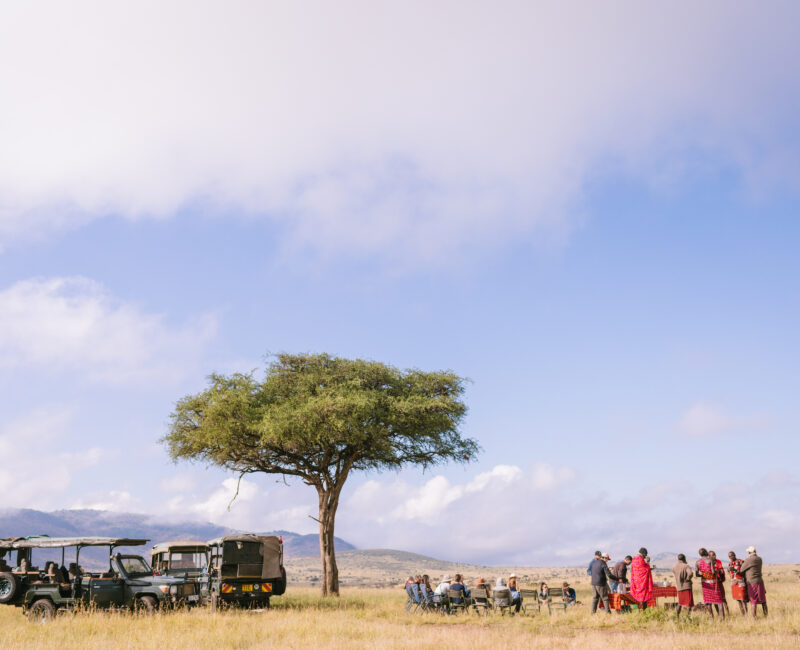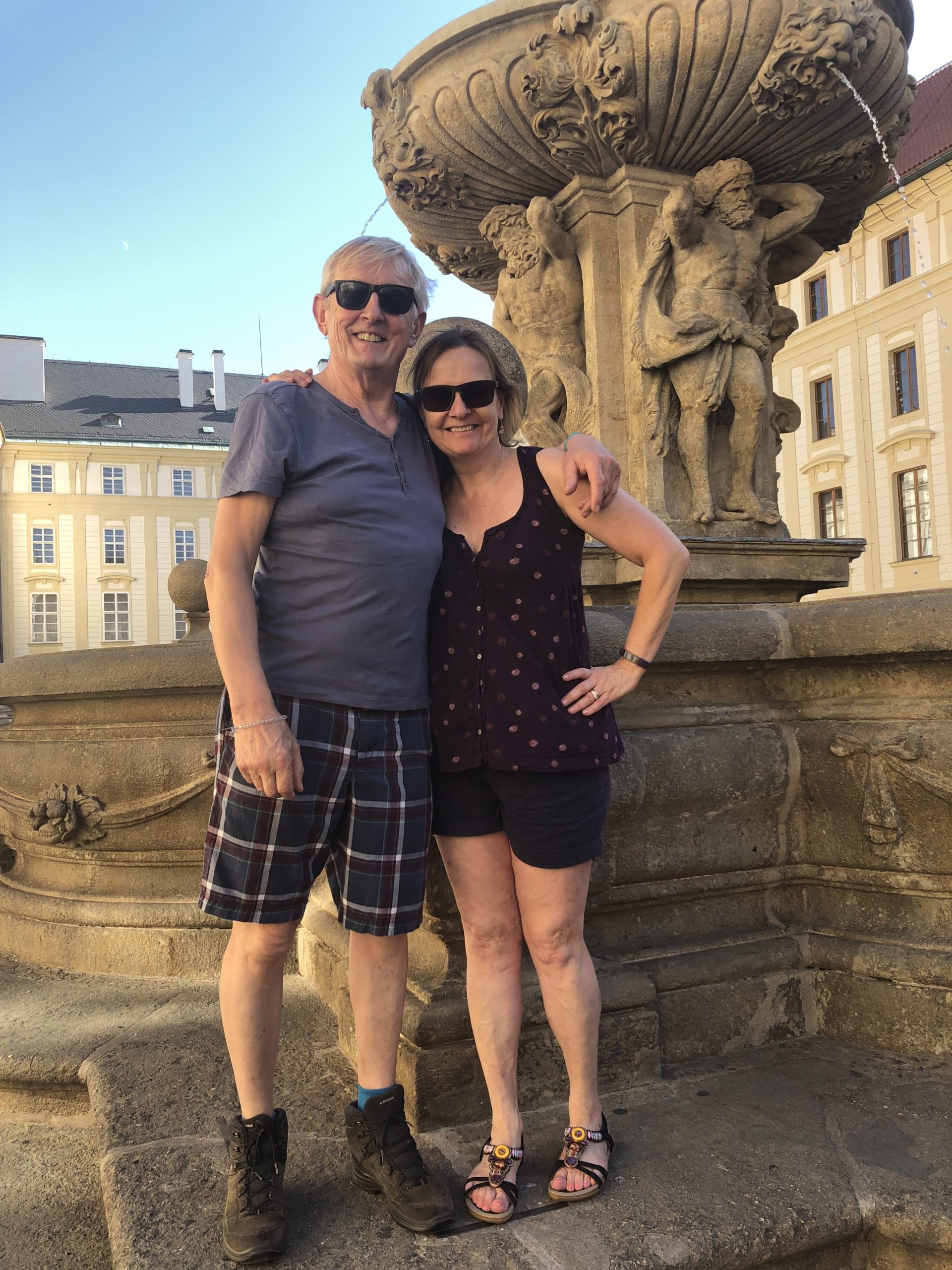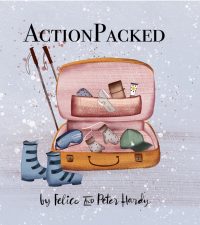
Photo: © Jodee Debes for Cottar’s
Peter Welcome to our travel podcast. We’re specialist travel writers, and we’ve spent half a lifetime exploring every corner of the world.
Felice So we want to share with you some of our extraordinary experiences and the amazing people we’ve met along the way.
Peter This week we’re in Kenya talking to safari camp owner, Calvin Cotter, whose family came here from the Great Plains of the Midwest in the years before World War One. In doing so, they exchanged bison and bears for buffalo, leopards and lions. Cottar’s is now over a hundred years old, and it’s still ranked the most exclusive of all.
I guess it’s a tribute in one way, to a world long gone…an exotic tented camp in the wilds of the Masai Mara, a throwback to the lifestyle, if you like, depicted in the 1985 movie Out of Africa. But in another, it’s a prime example of wildlife conservation and biodiversity in action.
Felice, you’ve actually stayed at Cottar’s 1920 and gone on safari with their Maasai guide. I know you’ve been on safari with half a dozen other companies. What’s so special about Cottar’s?
Felice The thing I found that made it different from other safari lodges was that Cottar’s is actually in the Masai Mara. You don’t have to go anywhere to go on a safari; you can just walk from your door. That’s the difference. On others where you have to go by jeep.
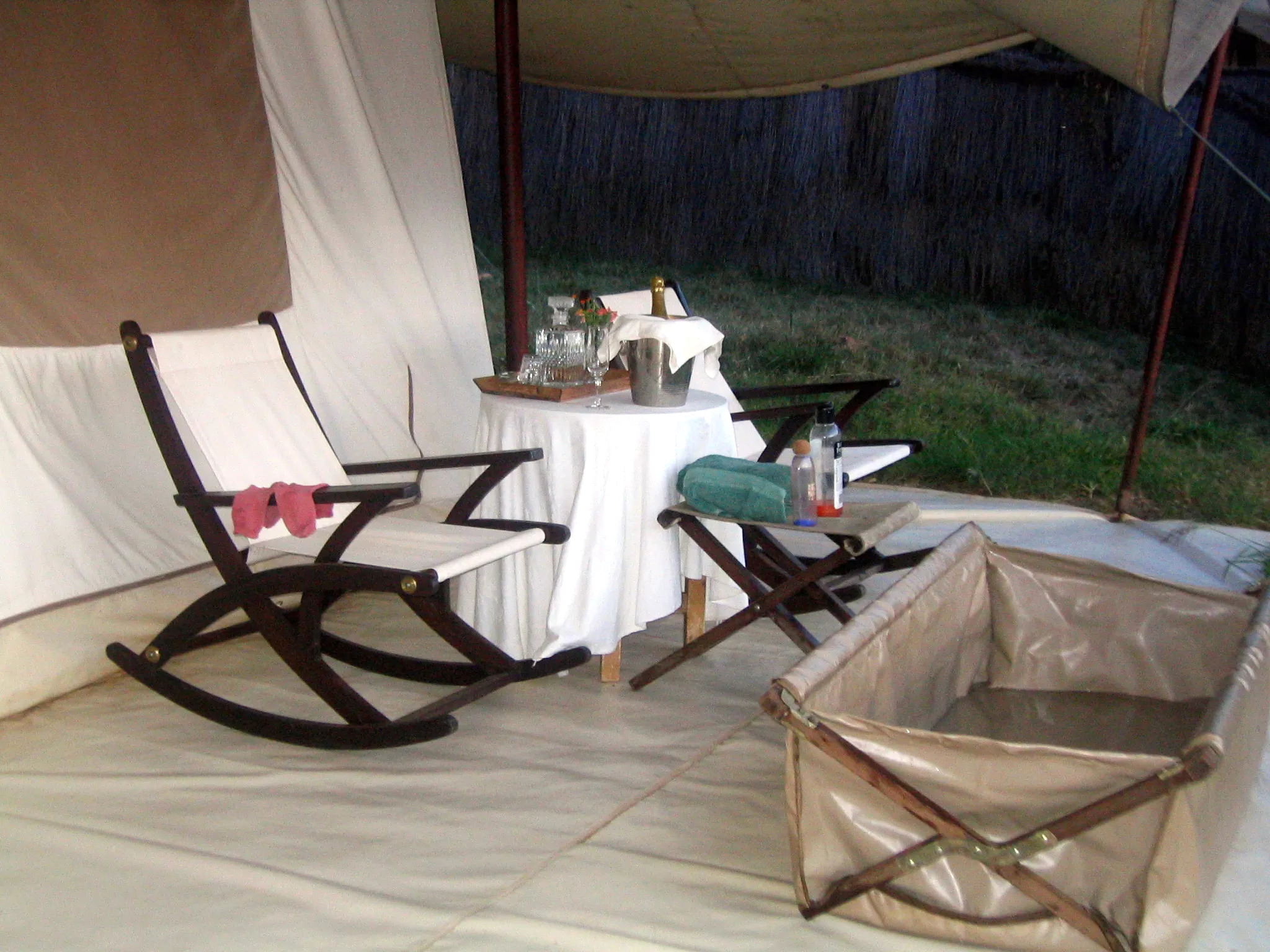
The canvas bath is ready for me at Cottar’s. Photo: © F.Hardy
We went on a safari drive, walking, and afterwards I was asked if I wanted to have a bath. I said, ‘Yes, ok,’ and I was told where to go for the bath. And along came four men carrying a fold-up canvas bath, an actual 1920s bath, which they then filled up with hot water, brought along a bottle of Champagne, which they put on a table next to it, and left me to have a bath.
So I got in the bath and the sad thing was having a bottle of Champagne and no one to share it with. But the view was absolutely amazing. I just felt I was out there in the middle of the wilds.
A man in Maasai robes carrying a spear accompanied me at all times from my tent to the main tent where the food was – and back.
Peter So did you feel safe?
Felice Yes, when I left my tent to go to the main tent for dinner, I was always accompanied by a man in full Maasai robes carrying a spear. He went everywhere with me. Well, the reason for this was to give, I think, all guests a sense of safety. I’m pretty sure the man would have been good with his spear if he’d needed it.
Peter Not faced with a charging elephant or something, maybe. But I think the point is that you were given that feeling of fear without actually being in any danger. It enforced consciousness of the potential threat of your surroundings.
Felice That’s right. That’s what I felt. In fact, an elephant did come into one safari lodge where I was staying; not that one.
Peter Calvin, It’s a long way from Oklahoma to East Africa. Can you explain?
Calvin Yes, it has been a long journey for the Cotters to get to Africa, because they had about two hundred years in the USA in the early days, including signing the Declaration of Independence in Savannah, Georgia. Our relatives were there at that time and, of course, were in the upheavals, the Wild West and everything. Eventually leaving the US to Africa from Oklahoma, a place called Lipscomb on the border of Texas, Oklahoma.
It was about the time of the beginning of the the plains being divided up, the sheep and cattle wars, and the fencing of the plains and the beginning of the destruction of the plains. These grass plains needed arrangements, you know, the bison would do the long distance ranging. And then, of course, the cattle guys knew that too. But the sheep guys didn’t want to do that. They basically saw the writing on the wall. Between that and reading Teddy Roosevelt’s book, Game Trails in Africa, they decided to come to Africa. So we’re talking about 1909.
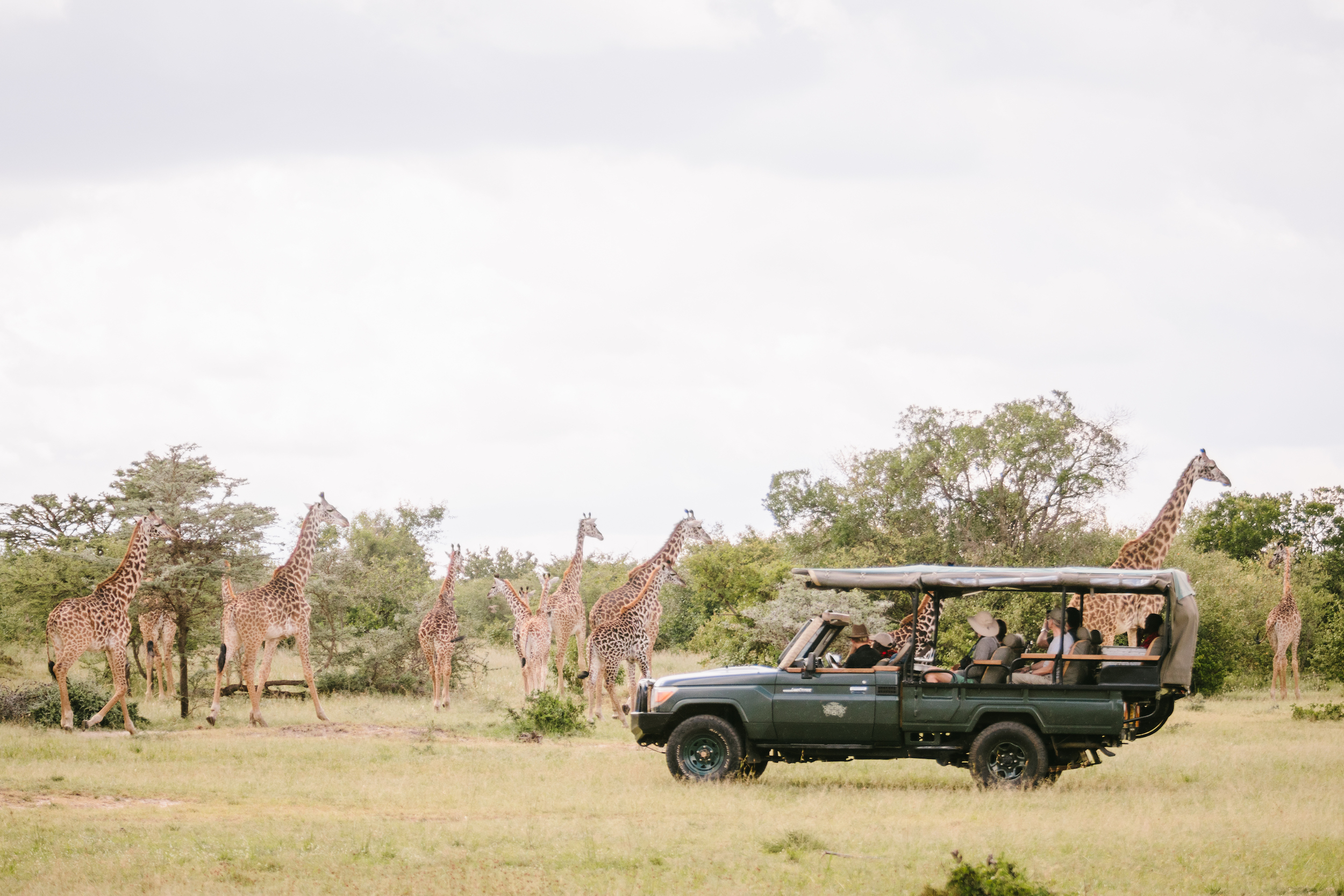
Photo: © Jodee Debes for Cottar’s
Calvin He came out and then he brought his family. He loved it so much. He brought his family, his whole family of six girls and three boys, and of course his wife, to settle or to live British East Africa at that time, from 1912. I would say the whole evolution of safari was through the family.
And bottom line is some of the most iconic, like Out of Africa. Baron Blixens and Karen Blixen were out here. They were thirty years after our family and they advised how to live, what’s going on. They were a small community at the time, but being Americans, we were not particularly in the high set, you know what I mean? We were the guys out there living in the bush a little bit rough. But to be honest, Negley Farson wrote a wrote a book about his experience, and he puts a few lines in there saying that amongst the most respected safari people in Africa was Charles Cotter, a very, very respected guy. He was wounded three times by leopard. He was eventually killed by a rhino. But the family have been involved, as I say, in creating camps, the whole concept of tented camps for tourists. That was one of my dad’s developments.
Peter How many people do you get at a time on a safari, or how many can you cater for?
Calvin We’re in the region of forty beds, which is on the top end of exclusive. So on the top end of personalised service, it’s maximum. Our conservation commitments are so big that we have to go commercial and make sure that we are big enough to be able to handle that overhead. Our model is leasing, so this is why we are that big.
What we’ve had to do is give the best of the personalised, original tented safari and yet have, I would say, the facilities and the luxury of a permanent hotel. But we don’t call ourselves a boutique hotel at all. We’re an experience, and the way our staff manage everything, the way we operate, is very much not as a hotel, more of an experience. It’s quite a subtle difference, primarily to do with the confidence of our staff and the fact that we don’t micromanage them so much. We have systems, but we very much choose our staff for their emotional intelligence and their ability to lead – all of them – at every level. They’re all leaders and initiative-driven people. So that is a major distinction between us and the normal hotels.
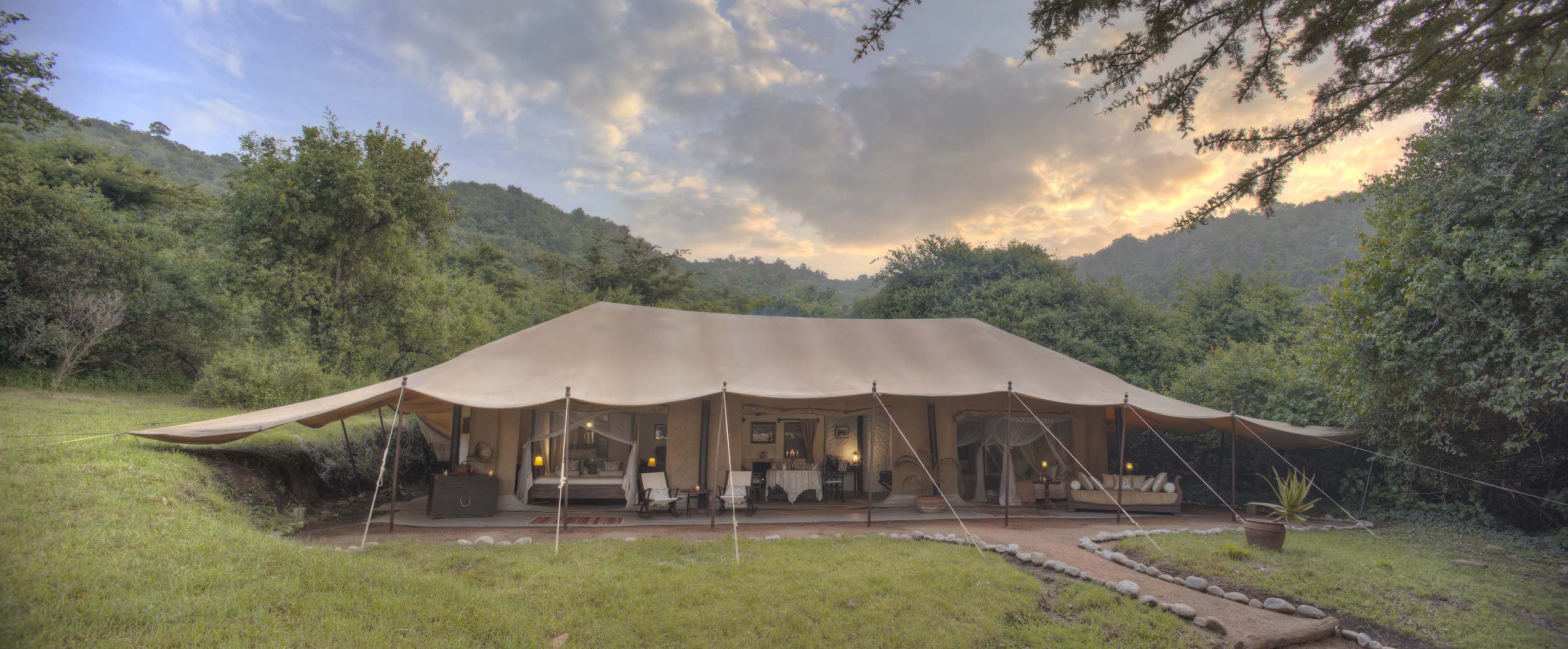
Cottars Family Tent
Peter I think what a lot of people who’ve never been on safari want to know is what actually happens? You arrive, you check in, and then what happens?
Calvin So what happens basically is when they come into Cottar’s camp will be very much an orientation of where everything is. The guide and our on-site manager will make sure everyone knows where everything is and the normal safety zones, like: don’t walk off the grass into the long grass sort of thing. When the lights, when the water works, and all the routines of camp, it’s very much an orientation.
Then basically the guide takes their group under their wing and they start to learn with their emotional intelligence, what are the capacity of the guests to, say for example, get up early and stay out, or long walks or short walks. So what is what is their capacity.
So you know, we’re quite high altitude. So for example at 6,300ft people don’t realise that you have to drink a lot more, twice as much water than you would normally at sea level….and those sort of things. So our guides are basically doing game drives and walks and going to the community villages to have people understand and to appreciate how the people are living in our area, the Maasai. And it’s very much experiential. So we’re unfolding Africa at the pace and at the interest level of the clients themselves.
And of course, new guests will want to see The Big Five straight away. You know they just they’re just there for the lions and the elephants, that’s what’s on their mind. They they want that hunger. They’re looking, they’re hunting for that. But in fact when they come on safari, they start seeing all the incredible small animals, insects, birds, and then eventually you get into this connectivity of all these species, like so many animals are connected with each other, plants and animals. So the variety of birds that are there and people come just for birds, they won’t even look at a lion. They’re just interested in that little LBJ that comes once a year from Europe.
Africa is our ancestral home. And the way I would put it is that a safari is not just another vacation. It is literally coming back to your human home and your DNA. Our DNA is geared for this environment. Basically, we’re feeling the emotions of our ancestors when we’re here. That’s what we’re feeling. That’s what you felt in that bath when you were here. And so we have people coming back multiple times, thirty, forty times over their lives, on safari to us.
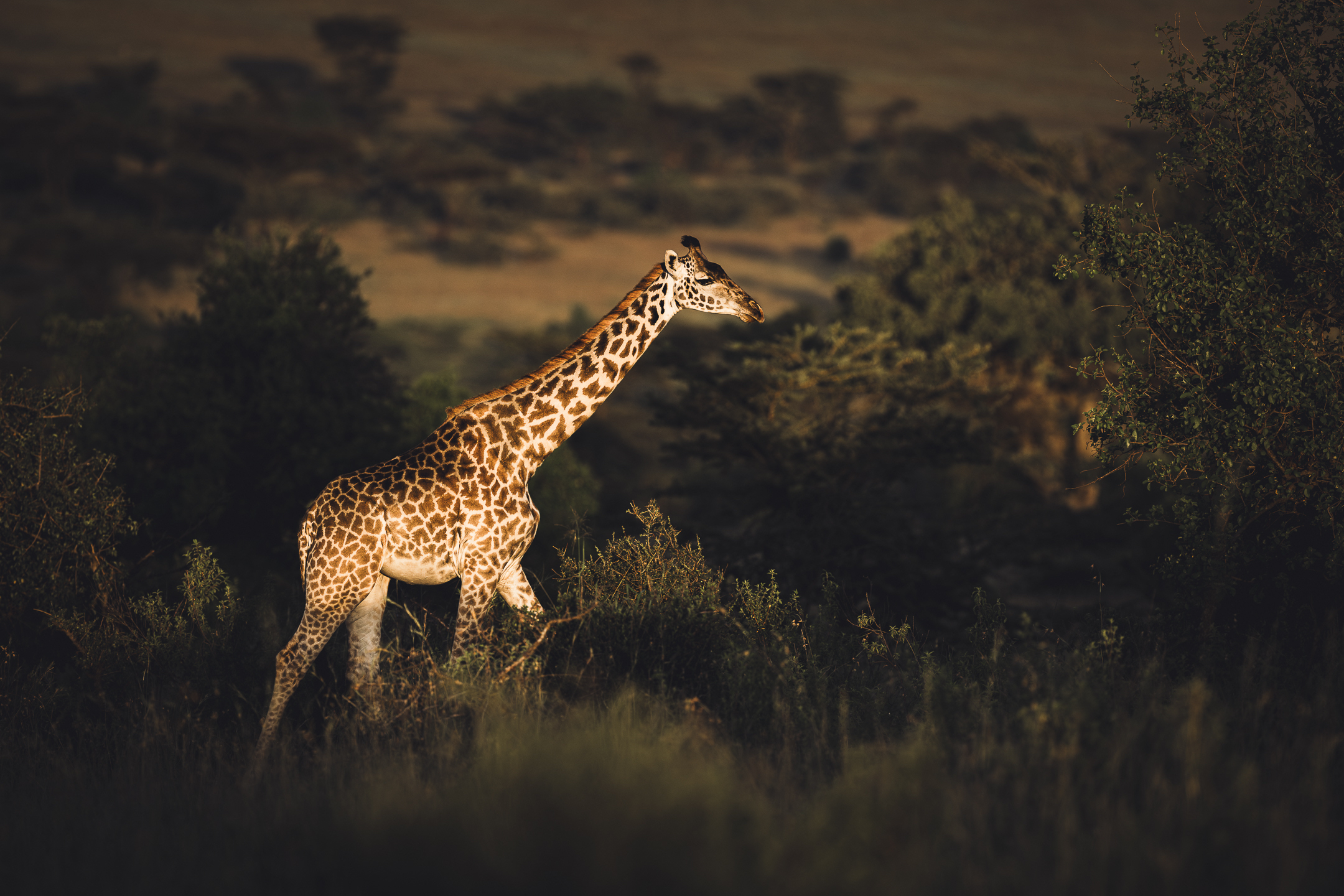
Photo: © Cottar’s
Felice: One of my favourite things about your safari was a walking safari, and I just felt so much closer to everything being on foot. It was incredible.
Calvin You know, walking is, of course, the next level. We offer everyone a walk. But really, what happens when you’re walking: you’re out of the moving, noisy vehicle blind, where there is not a human, but it’s not dangerous. So the animals are habituated to that.
But when you’re walking, you’re actually engaging with the animals as the super-predator, as the ancestral human that they have evolved to avoid. Everyone avoids a super-predator. So then depending on your guide and your ability, whether you can be perfectly safe when you’re walking because big elephants and buffaloes and lions can be dangerous if you bump into them. But you can be safe just by making noise and talking. Everything’s avoiding you.
But if you want to see the game close, then you’ve got to stalk like a lion. You’ve got to use the wind. You’ve got to get the right side of the wind, not have anything glinting. Most animals don’t see colour, so it’s all about contrast. There’s many tricks of getting close to the animals. You use your nose more, you use your ears more when you’re walking. You’re certainly using your adrenaline.
I often say the purpose of us as guides is to give people fear without being in danger. Because that is actually our ancestral…that is who we are, right? We are designed…the adrenal system, the hormones and cortisol…everything is designed for this environment: facing Big Five elephants and buffaloes and lions. So we try not to have the real danger, but we do walk with the Big Five and of course we’re protected. We’ve got our protection, you know.
Felice What sort of protection? What would happen if the worst came to the worst?
Calvin Well, I’d say at the end of the day, we do have a big gun, but we haven’t used that in years because my guides are highly trained to not put us in that position. And animals, they avoid humans, they don’t want a problem with humans. With wildlife, the big danger is if you get within their flight distance, and the flight distance is the distance in which they feel safe to turn their back and, and go away from the human, from the super-predator.
So if you find yourself in that position, usually:make a big noise – shout, clap, scream, that sort of thing. A very interesting indication is how the Maasai themselves walk in this environment. If they’re walking as a family, the men will walk fifty feet, or even meters, ahead of the ladies and the children. They will talk at the top of their voices to each other, because the men in front will carve the path through the wildlife, making it safe for the ladies and the children coming behind them. The main thing is the voices; the human voices are keeping everything away.
Felice Does that keep things like snakes away?
Calvin Snakes. Snakes are extremely…they know the difference between four-legged animals and two-legged animals. And they are very, very aware of getting out of dodge for two-legged, bipedal, animals…us specifically. So they have also learned over the last four million years that humans are dangerous and will kill them. The only ones that are dangerous to us really, are the puff adder, the slow-moving snakes, the adders, which is more a camouflage snake rather than a snappy fast cobra or mamba.
But these are not what we worry about in the bush at all. Where we are very few snakes, high altitude. No, I must say, for the place that has Big Five and everything, we’re actually one of the safest places on earth, considering, I would say.
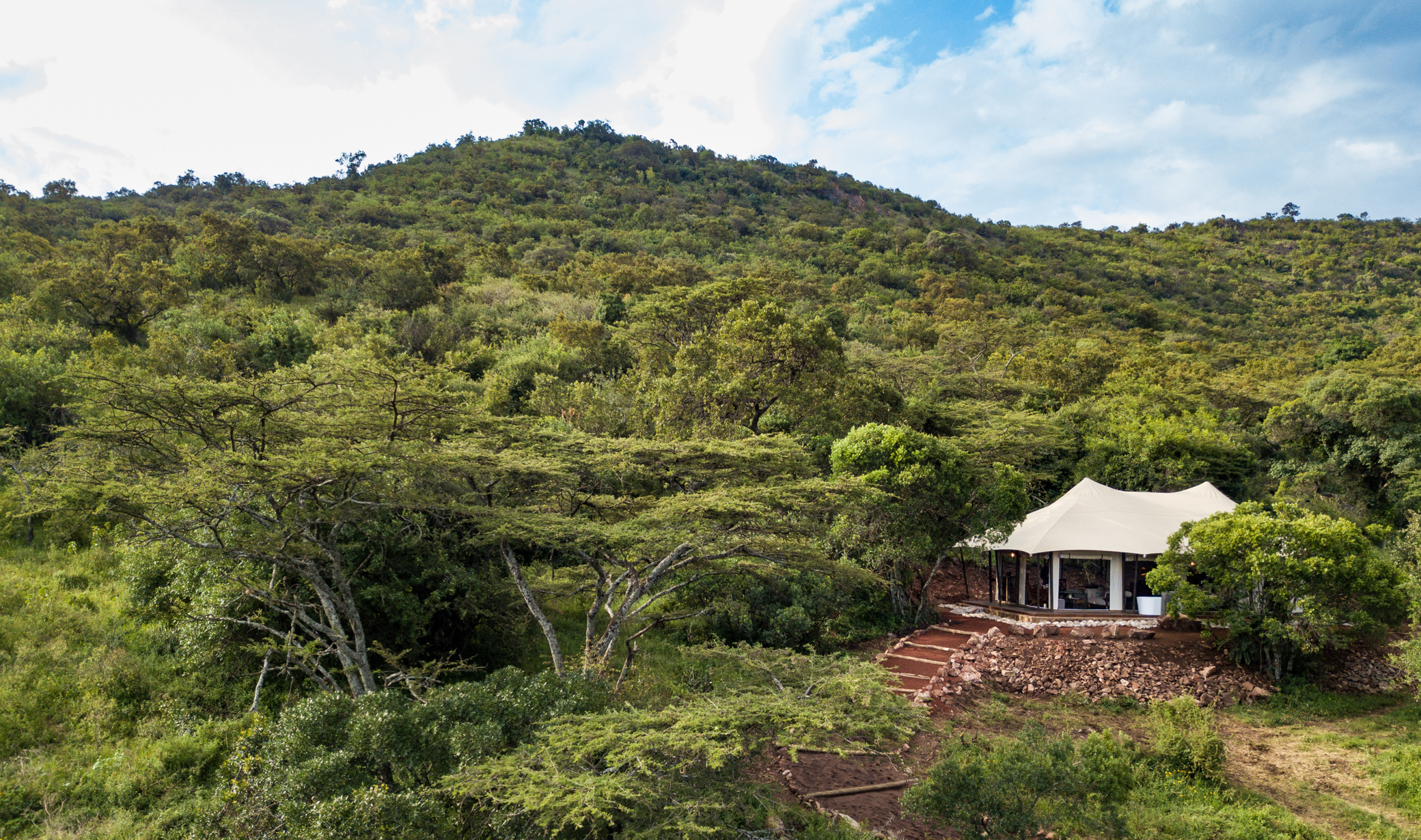
Molo Honeymoon Tent. Photo: © Cottar’s
Felice Yes, I always felt safe when I was there.
Peter Calvin, did you grow up in the camp?
Calvin Yes, I went to school in Kenya. I was at boarding school till I was fourteen. Then I joined my mum and my dad in the camp, and it was a tourist camp in the Mara at the time. Basically, I was from fourteen onwards just working for my father and my mother, and my sister was with me as well, and we ran the business altogether.
Felice What sort of job would you do at fourteen? What could you do?
Calvin Well, my mum insisted I continue doing a correspondence course, so I was actually trying to do mathematics – in between guiding, driving clients out… always with…Cottar’s always have a trusty spotter, a local fellow who knows where, who can also drive and everything. So that’s how I learnt to guide. That’s how I learnt to walk.
Of course I was walking before that on my own, running and generally just gambling around in the bush with my Maasai friends and on my own. So this was no long stretch for me just to get in a car and start driving guests around.
So there was that, and then my dad and my mum, of course, they wanted me to get stuck in at every level of the of the camp – like digging the trenches and understanding electricity and water, and everything that it takes to run. By the way, these camps, we are off the grid. We create our water system, our security, our power, everything that we need. We’re self-contained. So that’s kind of what I was doing, I was helping my dad on every element of that.
Then, at the age of eighteen, I went to work in Tanzania for another safari company. You know, it’s very important to not just be in the family bubble alone, and go and see how other people are operating. So I worked for an operation down there from ’84 to ‘89. I came back when Richard Leakey became director of Kenya Wildlife Service. I joined him and helped develop the Community Wildlife Service, which is an arm of the Kenya Wildlife Service.
We started the wildlife, what we call the District Wildlife Forums, which is an effort to devolve ownership of wildlife to landowners in those districts, six districts. Then I realised there was too much politics in that game, and perverse policies creating perverse outcomes. For example, state-owned wildlife is a problem in Kenya. And state-owned wildlife comes from the royal game, colonial, feudal wildlife laws of England. We inherited it as a state-owned wildlife. The problem is that with state-owned wildlife, it infers that the state is responsible and in control and has rights to all revenue from wildlife. And yet the cost of wildlife is local.
This is where my mindset around conservation changed, that the old fortress conservation of bad poacher shooting our beautiful animals, killing our beautiful animals….that’s actually not the truth of the whole story. The story is really about human-wildlife conflict, land use choices, and finding ways to get around that.
Anyway, so I evolved with Richard Leakey some new ideas. And then he lost his legs in an accident, an aircraft accident, and I went on back to join the family business. This is where the Cottar’s camps now evolved, the current Cottar’s camp evolved into this, from that time onwards. So 1998 is kind of where we started the current camp.
The current camp is called 1920s Safari Camps, and it does evoke the history of that wonderful golden era between the wars, very elegant, Out of Africa. There was less war in any period of history at that time than any other time. Of course, there was the issues of colonialism and still, you know, that was a difficult time for a lot of people. But in terms of the way the West perceives travel to Africa, it was Out of Africa – the film itself evokes a lot of wonderful memories or ideas about safaris.
So we went that route of making it beautiful, 1920s big veranda tents, white canvas, elegant dining rooms, lounges and a lot of leisure time in the safari, in between the walking and the game driving. And we’ve not stopped since then. We’ve just evolved it more and more into this personalised travel, experiential travel model, and more and more focused on the conservation.
We have to make tourism and safari camps and lodges much, much more responsible, because we don’t want to be seen in the future as the people who extracted the cash and left the disaster. Unfortunately, tourism around the world, nature-based tourism, does kind of go that route. In Kenya, I think of the gross revenues of tourism, only about two percent go to community conservation, outside of parks and reserves. And yet seventy percent of our wildlife is outside parks and reserves…so consider that.
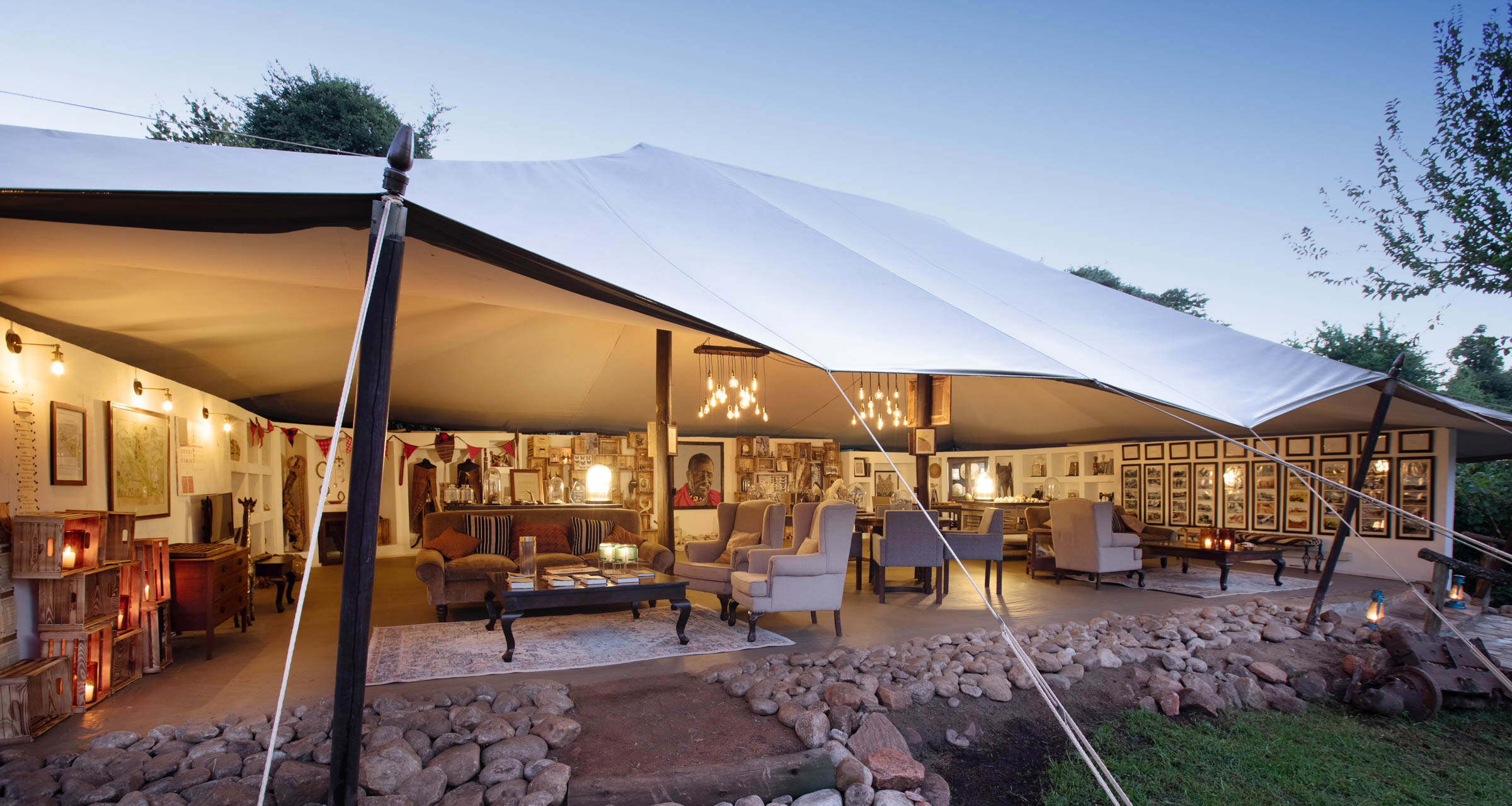
Photo: © Cottar’s
Calvin Louise, my wife at the time, and I were developing this business, we could see that the future was a cataclysmic decline in wildlife numbers and biodiversity. So we very much steered our efforts into working with the community and leasing the land…we call it a lease now, leasing the land, a direct lease. It’s all about giving the poor communities around us a reason to not change land use, remove the wildlife, remove the forest and do other things which on the face of it, may seem like a better plan for them. Actually in the long term, it is not, because climate change will make all of this subsistence farming unviable anyway, to a large degree, in Africa.
Felice Do you employ a lot of locals then for your camp?
Calvin We employ all locals, so eighty percent locals…as in Maasai locals, but otherwise all Kenyans. We have specialists from other parts of Kenya, but we’re very much in training and building up the capacity of the local Maasai. We have a community of 7,000 Maasai landowners around us, and we do clinics and bursaries and schools and teachers and water projects and micro-finance and women’s health. And we’re doing all of that stuff, as well as the conservation of, or the leasing of land, for conservancy.
Our area is called Olderkesie, and we are on the edge of the Maasai Mara National Reserve, right on the Tanzanian border. So it’s quite a critical part of the Maasai Mara itself. The wildlife and the Maasai Mara depend on the landscape to the east of us, to a large degree,
Peter How many acres do you have? Is it a big area?
Calvin, So we actually lease 7,000 acres, but the area to the east of us is…we’ve got growth plans to go into up to 60,000 acres in four phases. Then in the reserve we have access to 1600 square kilometres. And where we are, there are no fences. So it’s not like the South African model where every land unit has got a fence around it, where we are it’s pretty open. But if you go to the east of us, the landowners are starting to fence so that they can control wildlife into their crops. And this is, of course, terminal for wildlife; there’s no chance they can survive in that environment. So that’s my main effort, is to do this kind of conservation.
Felice When I was at your camp, one of the things I noticed was there were no fences, no walls. So you could just walk from the tent to anywhere. It was completely unprotected. It was an amazing feeling, completely wild.
Calvin We have good Maasai watchmen to make sure our guests don’t go traipsing off too far.
Felice: Yes, I noticed that.
Peter You must have had amusing rather than dangerous incidents over the years, funny things that happened?

Photo: © Cottar’s
Calvin Well, so many that I can’t even count or remember them, but a lot of close calls, I’d say, and some of the most beautiful times. I’ll just say one particular incident when I was about seventeen, or sixteen, I used to run on my own. My dad always told me, ‘Never run on your own, Calvin, because if you get clobbered by a buffalo elephant, how will we know where you are?’
But I was a stubborn teenager, and so I’d run on my own. I was coming back towards the camp, it was in the heat of the day and in a big yellow fever forest. But there was a little glade in the middle, and I was in the middle of the glade, and I saw the flick of a tail, a leopard’s tail, coming towards me. Now it’s very unusual for a leopard to be out at this time, 3:00 in the afternoon.
I stayed still. I stayed dead still, and this beautiful leopardess came past me, and she walked literally within five feet of me without realising I’m there. Of course, all these animals see movement. If you stay dead still and you’re not too contrasty, they will just go right past you. Basically, I was shaking for two hours after that because I didn’t know when she’d gone behind me, if she actually was just watching me and about to pounce. So I had to turn around very, very, very slowly.
What that did for me was it formalised in my mind, what we’re trying to do with our guests, to give them the truth of Africa, get folks on the ground walking and feeling the fear, but not really in danger like I was. And at the same time, what is it that we have to do to make biodiversity, wildlife, that leopard, that glade the best possible land use for the poorest people on the planet. Why and how?
It’s all about money, you know. It’s all about how do we get money that we’re earning and the government’s earning and tourism’s earning, and nowadays it’s carbon and biodiversity credits, and all of these new mechanisms coming into play, how do you get it down to the ground in a way that makes sense to the people on the ground? So developing those mechanisms, the collective benefit and liability model of payments is what we are really focusing on. That one incident, it steered my life forever. That’s why I’m doing what I’m doing.
Felice Would a leopard normally pounce, by the way, or only when they’re hungry?
Calvin So leopards, if they’re cornered, are extremely aggressive. So that was the danger of me walking. Rather, me staying still and the leopard getting too close to me and then realising there’s a super-predator human there. It would have been scratches all over me; that was the risk I took. I could have just stopped any chance of that by just clapping my hands when I first saw it coming, it would have just warned it and it would have gone on its way.
Normally leopards are not man-eaters in Africa; they’re much more man-eaters in India. But in Africa it’s very rare. Even in Nairobi there’s a few leopards always in the suburbs eating dogs and chickens and stuff.
Felice Do you have a dog? Because it’s quite dangerous for dogs, isn’t it, I think. When they’re young, they’re fine. They can get away from things, but when they’re older and have slower reactions. It’s interesting.
Calvin We have dogs in Nairobi and little group of friendly house dogs, but in the bush I wouldn’t have a dog because they would just be food. Even a big Great Dane would be taken up a tree by a leopard. They’re so much more powerful. In packs, dogs can tree a lion, or rather a leopard. But individually, one dog alone, no chance.
But the Maasai have got dogs. And the dogs, like all the livestock that the Maasai have got, come from Eurasia. They’re basically European species. They’ve evolved to be protection at night animals. You know, the Maasai boma their cattle, so they’re not killed at night. So they put them in a boma, and the humans live around in a circle around the cattle, compressed in a compressed boma, we call it. And the dogs are in there, and they make noises when they hear or smell hyenas and lions coming, and warn the humans. That’s the main function. So there’s plenty of dogs, but they’re often picked off by the leopard, I’m sure.

In the boma near Cottar’s. Photo: © F.Hardy
Peter What’s the best time of year to come on a safari?
Calvin Where we are in the Mara, it’s an all-year-round event. The Mara is not only about the migration, and that is what’s stuck in people’s minds that you’ve all got to rush to see the wildebeest crossing the river and being killed by crocs. But the Mara is actually not about that at all, that is one event.
The dry season is from June, July, August, and September into October. That is cool and dry. And that is when the migration is in. And then you get the short rains in November, and then it’s sort of green and nice throughout December, January, February; and then the long rains in April, May.
So there’s a price differential: the conservation fees, the entry fees are different in the rainy season, higher in the high season, and there’s more demand. The best time to come is in the in the low and the shoulder seasons, between the high season. Of course, the high season is popular because of the migration, but the Mara can be busy.
But we’re in an area that we, on purpose, work very hard to keep the masses out, not only in the Conservancy but inside the reserve itself. So we basically secure multiple sites so that there are no other hotels and lodges around us, and that we can control the experience that clients have. So you never get fifty cars around a leopard at Cottar’s, or that sort of experience that the Mara can be known for.
Felice How do you how do you get food to where you are for the guests?
Calvin Nowadays, we have trucks that come in and we contract the trucks to get there. Now it’s quite a lot of bulk loads, so it’s something we think about. But we do as much growing of food. We’ve got a little permaculture garden of our own for the freshest of the fresh. We also have aircraft coming, so we use ‘dead legs,’ what we call dead legs, empty legs of the aircraft, and we put goods on there as well. We’re pretty self-contained, actually. Our meat comes from the ranches in. You’ve got to have the best quality meat, you know, we can’t really buy the local cattle because they’re quite tough.
Peter How do guests actually get to you?
Calvin So normally we do a self-contained, all-inclusive package. We don’t want clients to arrive with their own car and driver, and then getting lost and different colours and two-wheel drive and all of that randomness. So we very much encourage people to just get on a plane land at Cottar’s, we control the entire experience from the moment you land to the moment you leave. So we’ve got our own vehicles. So it’s all by, I would say, 98% by aircraft, charter or schedule, we have both coming into our own airstrip.
Felice From Nairobi?
Calvin From Nairobi, from other destinations in Kenya. Now there’s more linkages with the coast like Laikipea and the whole north. So there’s quite a few more linkages now since you were out here.
Felice People tend to think of African safaris as being very expensive. Cottar’s is at the top of the tree, so presumably a stay with you costs a lot of money?
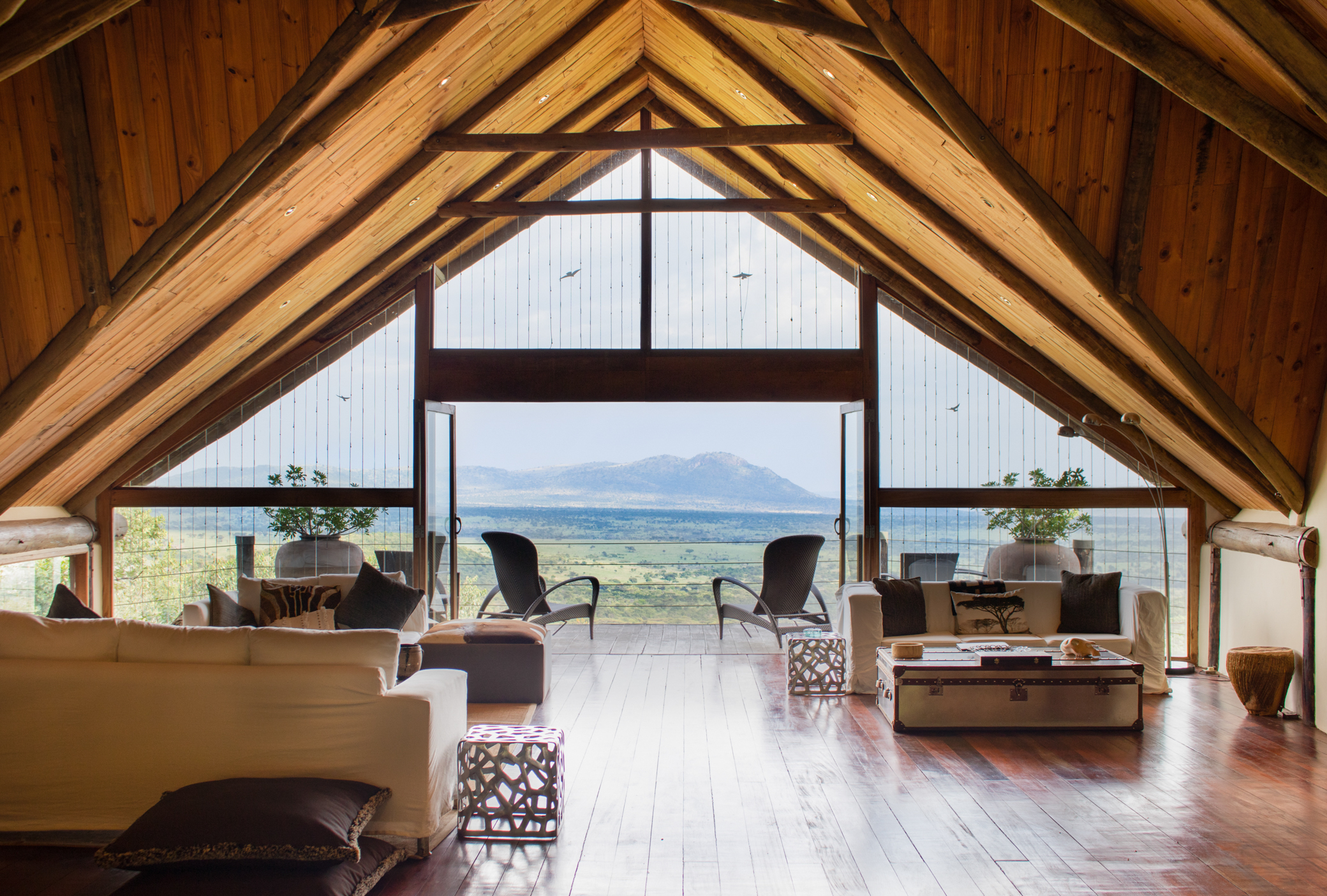
Photo: © Cottar’s
Calvin It is actually value for money. That’s what we all look at is like: what is the value? And I’ll just say like compared to a hotel in New York or London, it’s actually very cheap. But we do so much more. You have a full vehicle, you’ve got probably the most experienced guides in Africa guiding you around, giving you minute-by-minute an experience of your lifetime. It’s not just a hotel.
It’s a very interesting study in value. What is value? African wildlife is like a Rembrandt painting. It’s got value to someone. We are experts at costing that value and having people arrive at our camp to spend that money. And it’s our duty to convert that Rembrandt, I call it ‘Rembrandt value,’ towards living income for thousands of people. And that is really our role in the future of Africa. So it’s answering your question.
We cannot go so high that we lose all of our past loyal clients who’ve been with us forty, fifty times, because that is not us. We want our family to continue, and our past guests are our family. And yet we also need to find ways….and there’s new tourism coming up, like the villa model…there’s less involvement by the family, like me. It’s more of a contained, I would say, isolated experience for multi-generational families, as there are five rooms there. It’s very much higher value, higher cost and less involvement by us. But Cottar’s camp will never change much in what it charges, because we want to keep our old guests keeping on coming to Cottar’s.
Yes, of course we’re increasing by reasonable devaluation of the Shilling against the Dollar. That’s sort of reasonable amounts. A lot of our guests come back for their guides because the relationship they create with their guides, that’s actually the main reason they come back, is often about their guides.
Felice Calvin, thank you very much for coming on our podcast today. It’s been great talking to you.
Calvin Well, thank you for having me on the podcast and for letting me express what we do at Cottar’s and the importance of tourism in Africa.
Peter If people want to know more about your safaris, how do they get in touch with you?
Calvin There’s a website, www.cottars.com also on Instagram and TikTok @Cottar’s safaris. You can find us on social media quite easily as well.
Felice That’s all for now. If you’ve enjoyed the show, please share this episode with at least one other person! Do also subscribe on Spotify, i-Tunes or any of the many podcast providers – where you can give us a rating. You can subscribe on Spotify, Apple Podcasts or any of the many podcast platforms. You can also find us on Twitter, Facebook and Instagram. We’d love you to sign up for our regular emails to [email protected]. By the way, we’re no 7 in the Top 20 Midlife Travel Podcasts.
Also see our episode about Giraffe Manor in Nairobi.
© Action Packed Travel

- Join over a hundred thousand podcasters already using Buzzsprout to get their message out to the world.
- Following the link lets Buzzsprout know we sent you, gets you a $20 Amazon gift card if you sign up for a paid plan, and helps support our show.

